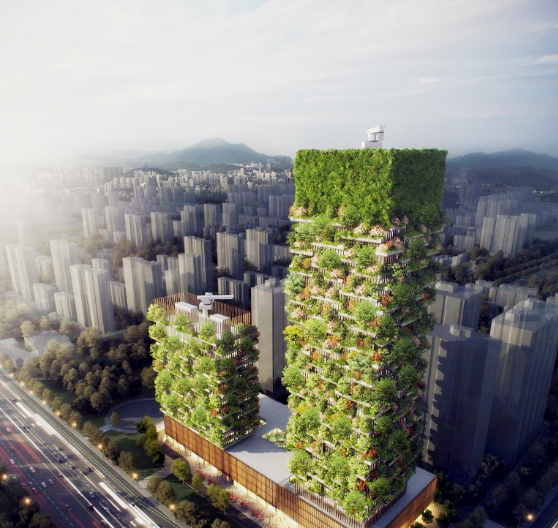Courtesy: weforum.org — They could be the breath of fresh air that pollution-choked cities desperately need. Vertical forests – high-rise buildings covered with trees and plants – absorb carbon dioxide, filter dust from pollution and produce oxygen. They’re also an ingenious way of planting more trees and creating habitats for wildlife in cities that are squeezed for space.
China, a nation experiencing rocketing urban growth and an air pollution crisis, is set to get its first vertical forest. The project in the eastern city of Nanjing is the brainchild of the Italian architect Stefano Boeri and his team, who built Milan’s Bosco Verticale (vertical forest), consisting of two residential high-rises at 110 and 76 meters with around 900 trees and over 20,000 smaller plants and shrubs.
The Nanjing vertical forest will be higher than its Milanese predecessor, with two neighbouring towers at 200 and 108 meters tall. Scheduled for completion in 2018, the complex will house a 247-room luxury hotel, offices, shops, restaurants, a food market, conference and exhibition spaces, a museum, a rooftop club and even a green architecture school.
The skyscrapers will hold 1100 trees from 23 local species and 2500 cascading plants and shrubs, which the architects say will provide 25 tons of CO2 absorption each year and produce about 60 kg of oxygen a day.
From vertical forests to forest cities?
To put things in perspective, saving 25 tons of Co2 would be equivalent to taking five cars off the road for a year. Chinese cities have some of the most polluted air in the world. In December, air quality got so bad that 24 cities across north-east China were put on “red alert”. Schools were temporarily closed, flights were cancelled, vehicles ordered off the roads and residents urged to stay indoors until the smog eased.
Boeri told The Guardian that while his vertical forest will only make a tiny difference in Nanjing, he hopes it will act as a catalyst for more green architecture projects. 
“Two towers in a huge urban environment [such as Nanjing] is so, so small a contribution – but it is an example. We hope that this model of green architecture can be repeated and copied and replicated,” he said.
His firm, which has offices in Shanghai, has even bigger plans afoot – forest cities. It has come up with a concept for the northern industrial hub of Shijiazhuang, one of China’s most polluted cities, which envisions a compact and green mini-city for 100,000 people with buildings of different sizes covered in trees and plants.
Today around 54% of the world’s population lives in urban areas – a proportion that is expected to increase to 66% by 2050, with most of the growth concentrated in Africa and Asia.
As more people move to cities, urban sprawl encroaches further into surrounding green space. Boeri conceived his vertical forests as a way of “giving back to nature the space we are taking from it”.
And the idea appears to be catching on. New examples of vertical greenery are springing up around the world, from Singapore’s “Supertrees” to Sydney’s One Central Park.
(Editor’s note: This article was written by Rosamond Hutt and originally appeared in weforum.org, on 04 May 2017.)

